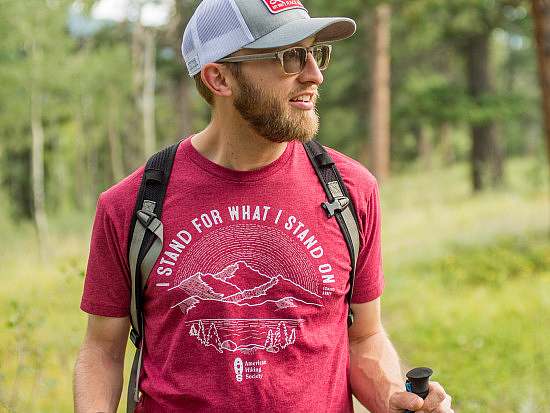Hiking in the Summer: Managing Sunburn and UV Risk

Summer Sun
There’s nothing like a summer hike – the clear skies, summer blooms, late sunsets. But along with these summer hikes come greater sunburn risks and other illnesses associated with heat. If you’re outside this summer, chances are you’ll be exposed to these risks, though that shouldn’t stop you from enjoying your time outdoors. Chief Medical Officer of GOES Health, Dr. Grant Lipman, shares what you can do to protect yourself in the summer heat.
What Exactly Is A Sunburn?
Sunburns happen when you’ve had too much exposure to ultraviolet (UV) rays from the sun, which penetrate the skin and cause damage to the cells. You may have experienced or seen a sunburn before, but did you know that they can happen in as little as 15 minutes? Everyone should protect themself from sun damage, but the amount of risk and preparation you need to take also depends on your location and personal history.
UV Light
UV light is a form of radiation emitted by the sun that travels in invisible waves or rays.
- UV C & UV B are shorter-length waves. They mostly get absorbed in the atmosphere by the ozone layer, but UV B can still penetrate skin and cause damage to skin cells and the eyes.
- UV A, like UV B, can also penetrate the skin and cause damage to the skin cells and eyes. It is a longer wavelength that is not absorbed at all by the atmosphere.
The UV Index (UVI) is a daily forecast of the expected intensity of UV radiation, on a scale from 0 to 11+. The higher the UVI, the higher the risk of harm from unprotected sun exposure. Check the UV index by the hour with GOES!

Protect Yourself
Enjoy your summer outside by following these 3 steps for sunburn prevention:
- Pack sun protection: Like hats, long-sleeves, SPF-treated clothes, sunscreen, chapstick with SPF, and sunglasses.
Did you know? Your eyes can get sunburnt too. While it’s important to protect the skin from UV rays, it’s also important to protect your eyes.
- Wear (and reapply!) sunscreen: There is no way to fully block all the harmful rays, regardless of SPF level. However, SPF 30 and higher is usually sufficient in blocking out most UV B rays. Sunscreen wears off, so should be reapplied every couple hours. Reapply more often if you’re sweating, in the water, when the UV index is very high, or if you are prone to sunburns.
- Find shade: This can be from your own sun protection (like a hat or long-sleeved shirt), or from environmental elements like trees or a rock wall. Solid barriers between your skin and the sun will provide your skin some relief.

Keep In Mind:
- Whether or not you get a sunburn, your skin may have still suffered damage from the sun. While melanin naturally protects skin from UV rays, people who have darker skin (with more melanin) still need to be mindful of sun protection.
- If you’re in areas with reflective surfaces like water or snow, sunlight will bounce off the surface and onto your skin and eyes. Sunburns can happen from exposure to direct UV light, or from UV light that is reflected.
Did you know? Water and snow increase the reflection of UV radiation by 80%; sand increases it by 15%.
- When you’re at higher altitude, there is less atmosphere to absorb the sun’s radiation, allowing UV rays to become more intense. There is a 2% increase of UV for every 1,000 foot gain in elevation!
- There is also less atmosphere to absorb UV radiation in the middle of the day (when the sun is closer to the earth), and in locations close to the equator.
- Sweat and water can remove sun protection from sunscreen, so be mindful of reapplying more frequently in these conditions.
- Sunburns make it harder for your body to keep cool because you cannot sweat as effectively through burnt skin.

Other Considerations
It doesn’t have to be a hot and sunny day for the risk of UV exposure and sunburn to be present. But when the weather is hot and sunny, you should be aware of the risk of sunburn, as well as other heat illnesses like:
- Sun Poisoning: A severe sunburn that can lead to dehydration, fever, and headache
- Heat Rash: Itchy, blistering skin
- Heat Syncope (passing out): Passing out from heat
- Heat Exhaustion: Overheating
- Heat Stroke: A medical emergency that occurs when the brain is affected by the body’s inability to cool down, injuring different organ systems
- Dehydration: Not enough water
- Hyponatremia: Overhydration and low salt levels
Each of these illnesses associated with the heat range from mild and temporary to dangerous, long-term, and even life-threatening. The best way to prevent heat illness is to prepare for it, learn to recognize the wide range of symptoms, and know when a situation is hazardous.
Luckily, GOES Health can help you assess symptoms, figure out what’s wrong, and guide you step-by-step to care for whatever it is you’re experiencing.
Download GOES today and enter AHS10OFF for 10% off a premium GOES+ subscription to access critical information from wilderness medicine experts.
Use GOES to prepare for your next hike by seeing the health risks ahead and manage outdoor injuries and illnesses, even if you’re off the grid. Make this summer hiking season a safer and memorable adventure!


